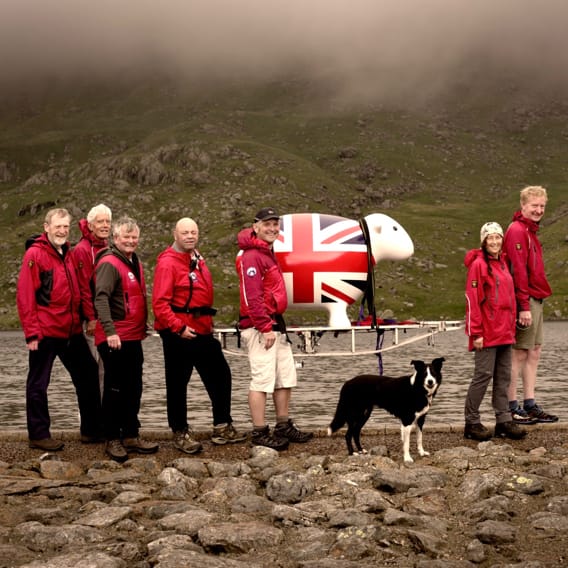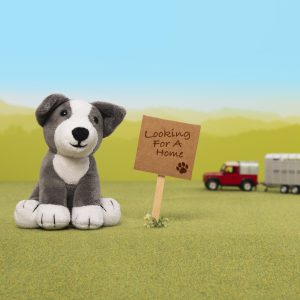Coniston Mountain Rescue

In the spirit of celebrating the wonderful #GreatBritishLakeDistrict we could think of no-one better to shine a spotlight than the amazing volunteers that put their lives at risk on a daily basis to help and rescue those who get into difficulty or injured on the high fells of the Lake District.
There are over 450 volunteer mountain rescue team members in Cumbria and the Lake District. The oldest rescue team in the UK is Coniston Mountain Rescue, celebrating their 70th anniversary this year. We spent the morning with the team to learn more about what they do and the challenges they face on a daily basis and we couldn't resist putting their skills to the test, rescuing Giant GB herdy!
This is their story, told by Coniston Mountain Rescue;
Since long before the Second World War, the good people of Coniston and surrounding areas have been rallying round to help those in need on the fells. Scratching together any available vehicles and equipment, they headed out in all weathers, hopeful that they could make a difference and return a casualty to the safety of the village. In January 1947, following a pivotal incident, it was agreed that Coniston needed a more formally organised search and rescue team and the Coniston Fells Rescue Party was formed, under the leadership of Local Mountain guide Jim Cameron. 70 years later and Coniston Mountain Rescue Team continue to turn out in all weathers, whatever the time of day or night, 365 days of the year.
During rescues, our specially trained casualty carers deal with a wide range of injuries and illnesses. Sprains, strains, broken bones, heart attacks, hypothermia or even multiple injuries from motor bike mishaps; whatever the incident, casualties are dealt with calmly and efficiently (and with good humour), before being evacuated by the rest of the team to the reassuring safety of our vehicles or an awaiting ambulance. We also have the support of the Great North Air Ambulance, North West Air Ambulance and Coastguard helicopters who can assist in the treatment and evacuation of casualties where necessary. But it’s not just about the injuries…
In years gone by, a callout for a lost person meant hours spent scouring the fells as Team members and search dogs endeavoured to locate walkers who were last seen ‘heading in the direction of Wetherlam’ for example. With the invention of the mobile phone and (more recently) a nifty little computer program called SARLOC, this job has, thankfully, become somewhat easier and we are often able to locate lost walkers to within 5-10 meters of their position. Of course, technology isn’t infallible, and we still train for traditional searches.
Like searches, crag rescue has also come a long way. Where once safety meant a hemp rope tied round your waist, these days we use pulley systems and multiple anchors to safely ascend or descend with casualties on stretchers. Wrapping the casualty in a warm Casbag (think thick, heavy-duty sleeping bag) or a vacuum mattress (designed to immobilise an entire body in cases of suspected spinal or pelvic injury), further ensures their safety during the rescue.
Over the years crag rescues have included fallen climbers; a severely broken pelvis belonging to a casualty stranded on a small ledge; lost walkers who turned out to be crag fast climbers and walkers who have become stuck on climbing routes after taking a wrong turning.
When a call for assistance arrives, it’s most common for the caller to either be with the casualty or, sometimes, the casualty themselves. However, there are times when we are mobilised in response to a ‘call with good intent.’ This is where a helpful soul has heard, or seen, something leading them to believe someone needs help. This has resulted in some humourous incidents in which the team has searched fellsides for a sheepdog called ‘Hope’ or one of our own out for a night-time ramble! While some may suggest that these types of calls waste our time, we would never consider criticising them. To employ the age-old cliché: it really is better to be safe than sorry, and it’s all good practice.
And it’s not just fells. The Coniston area is as well known for its extensive mine workings (both copper and slate) as it is for its fells, and the team are just as prepared to venture underground as they are ascending crags. One notable rescue was the gentleman who fell through two levels and survived – each drop being around 75 feet. There was also the time one lucky individual survived a prolonged stay down a mine shaft thanks to the Mars bar in his pocket – if you hear locals talking about the Mars Bar Mine Shaft, you now know what they’re talking about!
However, perhaps the most memorable mine incident must be the unexploded bomb of 1995. Members of the team made the discovery while training down a mine. Initially not realising what they had found, many photographs were taken of team members posing on it. Needless to say, we required the assistance of army bomb disposal on that incident! And for the record: the bomb was a viable device, it weighed about 80 lbs and the fuse had been lit – thankfully, for both the team and Coniston, the fuse had gone out before it reached the explosives.
It should also be noted, that for technical mine rescue incidents, we can call on the experts of COMRU (Cumbria Ore Mines Rescue Unit) a specially trained rescue team whose main expertise is mine rescue.
A number of the team are also swift water technicians, qualified to work in dangerous water whether lake, river or ravine. During Storm Desmond’s flooding in 2015 this team supported the emergency services in a range of roles: locally, assisting vulnerable people with emergency transportation where needed; within Cumbria, with the evacuation of properties in Carlisle and nationally, travelling to York to assist with property evacuations there.
But, rescues aren’t just limited to humans… over the years the team has assisted numerous animals in peril. We have searched for lost dogs, rescued crag fast sheep and herded horses to safety following an incident involving a riding group. The team’s animal rescue skills were again put to the test in June this year when a Herdwick lamb, with a broken leg, became stuck in mine workings. Successfully extracted, the lamb was returned to the farmer.
Mountain Rescue requires teams to be proficient in a vast range of technical skills. It is for that reason that we train constantly. In addition to any call outs, the team meet once a fortnight for training – sessions that might cover advanced first aid, rope rigging systems, search techniques or even just area familiarisation. In addition, team members attend courses on off road driving, rope rescue, equipment safety, swift water, first aid…to name but a few.
And our commitment doesn’t stop there. As a charity, we rely on donations to fund our ongoing work. In what remaining spare time team members might have, we also marshal trail races round the Coniston fells and host talks at our base to different organisations. We are never off-duty.
The team ranges in age from 18 to 76. Some of us have families. Some of us are retired. Some of us work full time. But whatever our backgrounds, ages or interests, we have one thing in common: we are all proud to call ourselves volunteers for Coniston Mountain Rescue.
Herdy would like to thank the Coniston Mountain Rescue team for being such great sports and giving us an unforgettable experience on the day. We’d also like to thank all the other Lake District mountain rescue teams who put their lives on the line; these guys really do embody everything that’s great about the #GreatBritishLakeDistrict.
Coniston Mountain rescue: http://www.conistonmountainrescue.org.uk
Lake District Search & Mountain Rescue: http://www.ldsamra.org.uk





